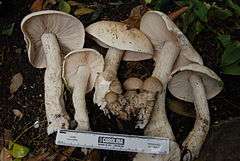Macrocybe
Macrocybe is a genus of fungi in the family Tricholomataceae. The genus contains seven species, widely distributed in tropical regions worldwide.[1]
| Macrocybe | |
|---|---|
 | |
| unidentified Macrocybe species | |
| Scientific classification | |
| Kingdom: | |
| Division: | |
| Class: | |
| Order: | |
| Family: | |
| Genus: | Macrocybe Pegler & Lodge (1998) |
| Type species | |
| Macrocybe titans (H.E.Bigelow & Kimbr.) Pegler, Lodge & Nakasone (1998) | |
| Species | |
|
M. crassa | |
The genus was established in 1998 by mycologists David Pegler and Deborah Jean Lodge, for several large white tropical species that had been placed in the genus Tricholoma.[2] The name is derived from the Ancient Greek words makros "long" and kube "head". The genus is related to the genus Calocybe.[2]
The species form huge pale fleshy mushrooms that often grow in clumps on dead wood in the ground. The weight of the cluster may exceed 30 kg.[2] The caps are convex to depressed, and sometimes have a central boss (umbo), and are white to cream or pale ochre or grey. One species, M. titans, has a cap that can reach a metre (40 in) in diameter. The white gills are sinuate. The flesh is white and does not change colour when bruised. The stipe is white and often has a swollen base. The spore print is white. The round to oval spores are less than 10 micrometres long and smooth.[2]
The species are saprobic, growing on dead wood in grass generally.[2] One species, M. gigantea, has been found growing on elephant dung in Kerala state in India,[3] and M. crassa has been cultivated on horse manure in Thailand.[2]
Some species have tasty mushrooms, which are eaten in the tropics.[2] An undescribed species is eaten by the Patamona people in Guyana.[4] Although edible, some species do contain traces of cyanide that require cooking to eliminate.[2]
Species
Seven species are recognised, with M. titans designated the type species.[2]
- M. crassa – Sri Lanka, India (Kerala), Malaysia
- M. gigantea – India (West Bengal), Pakistan, Nepal
- M. lobayensis – West Africa
- M. pachymeres – Sri Lanka, India
- M. praegrandis – Brazil
- M. spectabilis – Mauritius, Japan, Hawaii
- M. titans – USA (Florida, Puerto Rico), Costa Rica
References
- Kirk PM, Cannon PF, Minter DW, Stalpers JA (2008). Dictionary of the Fungi (10th ed.). Wallingford, UK: CAB International. p. 396. ISBN 978-0-85199-826-8.
- Pegler DN, Lodge DJ, Nakasone KK (1998). "The Pantropical Genus Macrocybe Gen. nov". Mycologia. 90 (3): 494. doi:10.2307/3761408.
- Manimohan P, Agretious Thomas K, Shiva VS (2007). "Agarics on elephant dung in Kerala State, India" (PDF). 99: 147–57. Cite journal requires
|journal=(help) - Henkel TW, Aime MC, Chin M, Andrew C (2004). "Edible mushrooms from Guyana". Mycologist. 18 (3): 104–11. doi:10.1017/S0269915X04003027.